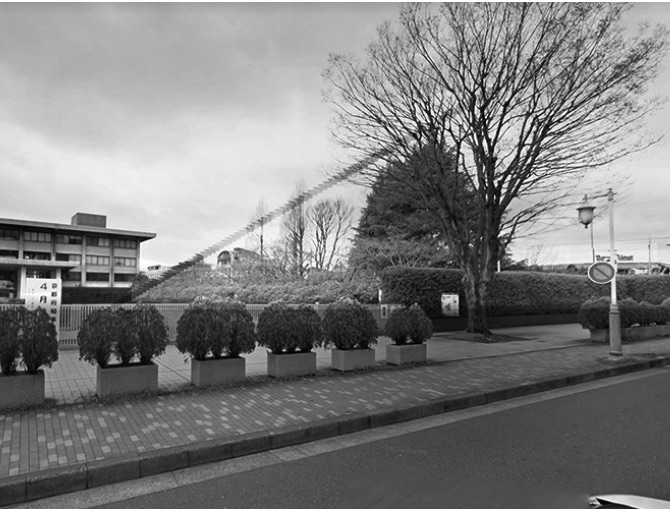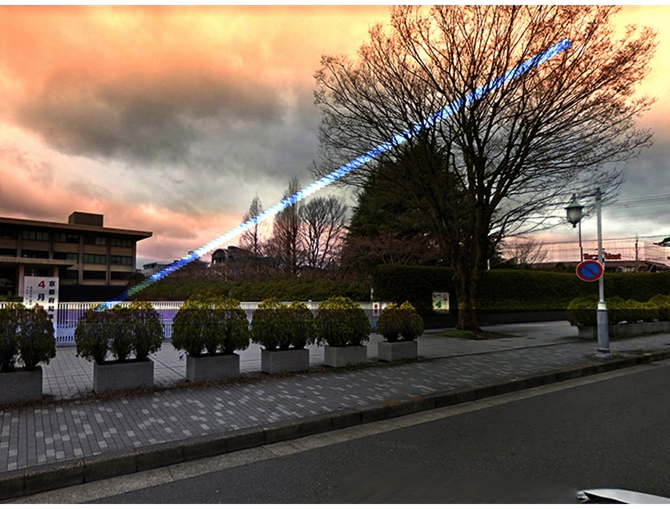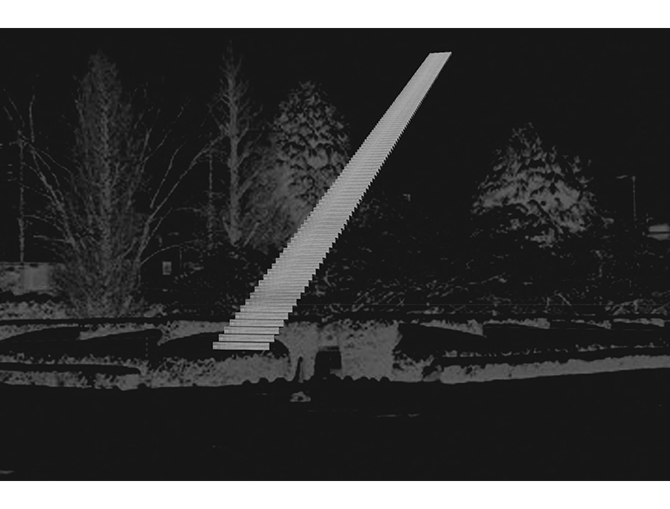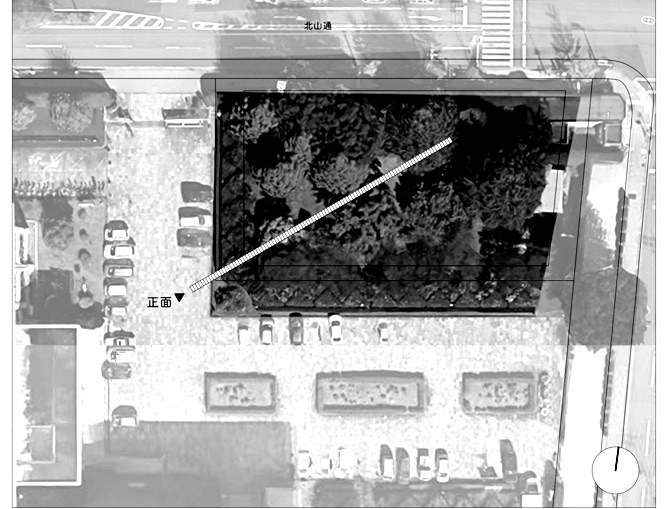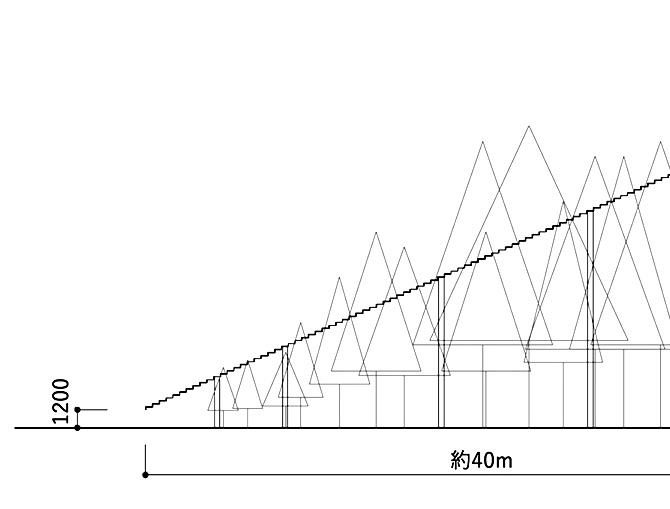
『永遠 〜はるのよの ゆめのうきはし とだえして みねに わかるる よこぐものそら〜』
2018、京都
京都文化力プロジェクト2016-2020の一環として行われた実施コンペで、京都の北山通り沿いにある旧京都府立総合資料館の前庭に、制作補助費500万円で自由に空間インスタレーションを提案するもの。
審査員は、安藤忠雄(建築家)、片岡真美(森美術館チーフ・キュレーター、京都造形芸術大学教授)、建畠哲(京都芸術センター館長、多摩美術大学学長)の3名。
concept
『春の夜の夢の浮橋とだえして峰に別るる横雲の空』(藤原定家「新古今和歌集・巻第一・春歌上38」)
(現代語訳)
春の夜、まるでゆらゆらと頼りない浮き橋が途切れるように儚い夢が途切れて目を冷ますと、山の峰を横雲がゆっくりはなれてゆく夜明けの空が見渡せるのでした。
このインスタレーションは、京都に大変ゆかりの深い鎌倉時代の歌人・藤原定家の代表的な歌の世界と現実の世界をつなぐものです。
この歌は、大切な人との出会いと別れを「儚い夢」に例えていると言われ、そこには「儚い夢」であっても、それが永遠に続くことを望む「永遠性」への希求があると思われます。そして、「横雲」の動きが絶妙に空の存在を強調し、「空」がその夢の”儚さ”を象徴的に物語っています。
このインスタレーションで設置するのは、「永遠」の象徴でもある「空」に向かって上昇(希求)し、夜にはぼんやりと発光しながら空中に浮かぶ階段のみです。
空に向かって永遠に上昇するかのような階段は、階段の始まる場所(現在の自分)とそのつながる先である不確かな場所(夢の中の自分)をつなぐことも意味します。
ある人は、そこに遠い未知なる世界とつながることを夢見るかもしれません。又ある人は、今は亡き愛する人が舞い降りてくることを夢見るかもしれません。
この歌を意識しながら、天空へと一直線に伸びる階段に思いを馳せることで、「遠い過去の京都」=「現在の自分(がいる京都)」=「未来の京都」を意識的につなぐことでしょう。
(ちなみに、京都府立総合資料館には、仁融筆の写本「新古今和歌集」が保存されています)
"Eternity ~ Harunoyo no Yume no Ukihashi Todaeshite Mineni Wakaruru Yokogumonosora ~"
This was a competition held as part of the Kyoto Power of Culture Project 2016-2020, in which participants were free to propose a spatial installation in the front garden of the former Kyoto Prefectural Library and Archives along Kitayama Street in Kyoto with a production subsidy of 5 million yen.
The judges are Tadao Ando (Architect), Mami Kataoka (Chief Curator, Mori Art Museum, Professor, Kyoto University of the Arts), and Akira Tatehata (Director, Kyoto Art Center, President, Tama Art University).
concept
"A Floating Bridge in a Spring Night's Dream and a Sky of Horizontal Clouds that Falls to the Peak" (written by Fujiwara no Teika in Shin Kokin Wakashu Vol.38)
(modern language translation)
On a spring night, when my fleeting dreams were interrupted and my eyes cooled down, just like an unreliable floating bridge was interrupted, I could see the dawn sky as the clouds slowly drifted away from the mountain peaks.
This installation connects the world of the representative poems of Fujiwara no Teika, a poet of the Kamakura period, who has a deep connection with Kyoto, and the real world.
This song is said to compare meeting and parting with a loved one comparing "ephemeral dream", and even if it is a "ephemeral dream", there is an "eternity" that hopes it will last forever. It seems that there is a desire for “eternity”. The movement of the "horizontal clouds" exquisitely emphasizes the existence of the sky, and the "sky" symbolically tells the "ephemeral" of the dream.
The only thing installed in this installation is a staircase that rises (seeks) toward the sky, which is also a symbol of eternity, and floats in the air while dimly emitting light at night.
The staircase, which seems to rise forever into the sky, also means connecting the place where the staircase begins (my present self) and the uncertain place where it leads (my dream self).
Some may dream of connecting with a distant and unknown world there. Others may dream that a loved one who is now dead descends upon them.
While conscious of this song, by thinking about the staircase that stretches straight to the sky, we consciously connect “Kyoto in the distant past” = “Kyoto in the present” = “Kyoto in the future”.
(By the way, the Kyoto Prefectural Library and Archives preserves a manuscript.)
■空間インスタレーション
鉄骨造
構造設計:平岩良之
■ a temporary architecture
Structure: steel
Structural engineers:YOSHIYUKI HIRAIWA

